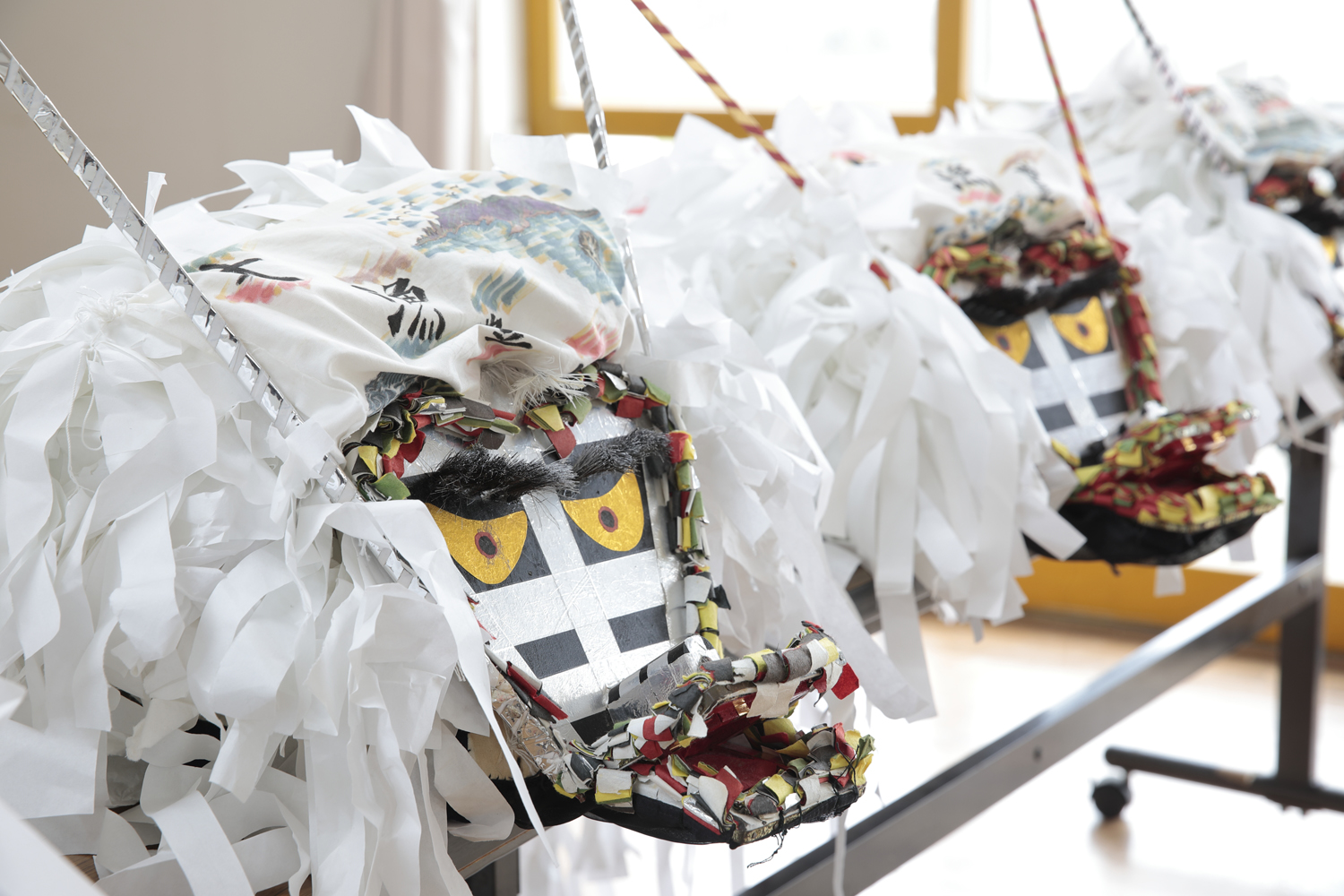
Shishi deer head overflowing with a handmade touch

Shishi deer head overflowing with a handmade touch
“Simply put, three male shishi deer fight over a female shishi deer, and an elder shishi deer called shirasagi (white deer) tries to calms them down.”
Takeuchi Tsuyoshi, a member of the preservation society, told us about the details of the Gokatte shishimai deer dance.
In fact, if you watch the video of the Gokatte shishimai deer dance on the YouTube channel of the Esashi Town Museum, you will see three male shishi deer fighting fiercely over a female shishi deer. It is indeed powerful and manly.

A picture taken at a performance in a cypress forest (photo by Gokatte Shishimai Deer Dance Preservation Society)
In addition to the five shishi deer dancers, at least 13 members are essential to the performance, including a singer called the oyaji, a daigasa large umbrella bearer, taiko drummer, sasara bundle, chagama tea kettle, and fue flute. The rhythm of the taiko is the driving force behind the performance.
In most cases, the less dynamic female shishi deer and the elder shirasagi deer are performed by the more elderly, while the three male shishi deer are performed by younger people. Every year in May, the dance is presented on stage at the Esashi Oiwake Kaikan, and is also performed at festivals held at shrines.
The Gokatte shishimai deer dance is a folk performing art that has been passed down for generations in the southern part of Esashi, which was once known as Gokatte.

Miyahara Hiroshi (left) and Takeuchi Tsuyoshi
According to Miyahara Hiroshi, a curator at the Esashi Town Board of Education, there are two different types of shishi deer dances. One is the futaridachi shishimai deer dance in which two or more performers maneuver one shishi deer, and the other is the hitoridachi shishimai deer dance in which a single performer portrays the shishi deer. The hitoridachi shishimai deer dance is found only in eastern Japan and is not found in western Japan.
“The shishimai deer dance with multiple hitoridachi (1-person) shishi deer can only be found on the western side of the Oshima Peninsula in Hokkaido. According to written records, the dance was first performed at the end of the 18th century, but the exact time of its introduction is not clear. I think that each region came up with its own origin connected to the history, culture, and livelihood of the area.”

From left to right: Blue shishi deer head, female shishi deer head, white shishi deer head, red shishi deer head, and black shishi deer head. They are kept in a local community center.
The Gokatte shishimai deer dance has continued for at least 200 years but the lyrics and composition have changed over time.
Miyahara says, “As people change, naturally the way they dance will also change. Songs are also sung in the way the people want to sing them. The lyrics are now in print, but in the old days, people imitated what they heard, and there are parts of the lyrics that they did not understand well.”
What is more important than the need for accuracy is the fact that it is passed down in the local community.
Miyahara also commented, “Intangible cultural properties are supposed to change.” The most significant thing is that the tradition continues, changing little by little to meet the demands of the times and the actual conditions of the region.
Currently, there are more than 20 members of the Gokatte Shishimai Deer Dance Preservation Society. Their ages range from first-year high school students to those in their 80s.
The question of how to preserve and pass on the dance in the future is a major challenge.
In addition to the Gokatte shishimai deer dance, there has also been the Esashi shishimai deer dance, Tazawa shishimai deer dance, and Domba shishimai deer dance in each village in Esashi, each of which boasts a long history.
However, the preserving the tradition has been difficult due to factors such as the declining birthrate and aging population, and the Esashi shishimai deer dance has already disappeared.
One wonders if the government can provide support or allocate a budget for this tradition. When told this, Takeuchi immediately rejected the idea.
“I feel like if the performance is given a budget, it will not survive. We have always operated using our membership dues and performance fees. If we request subsidies from the local government, we will end up doing the performances for money, and I don't think we will be able to continue.”
Takeuchi is also an employee of the town hall where he works as the head of the town's welfare department.
The members do not continue to perform for the sake of performing on stage. At its core, it is about getting together with fellow members of the community and having a good time. It is fortunate that the culture of enjoying local performing arts has been instilled in the local community.

Members of the Gokatte Shishimai Deer Dance Preservation Society (photo by the Gokatte Shishimai Deer Dance Preservation Society).